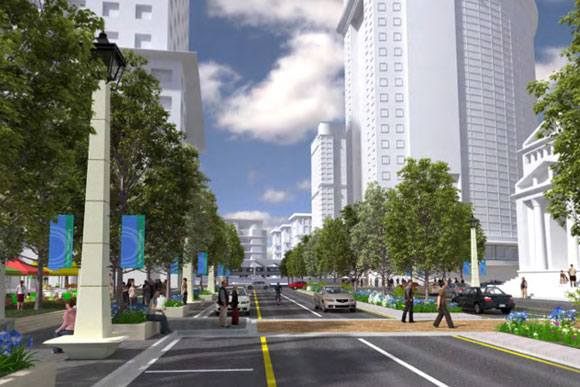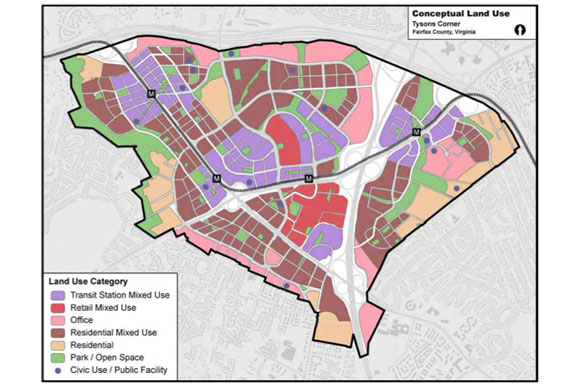The Silver Line's ridership is growing. Some businesses are already seeing a boost, but others say they're in it for the long haul, not an instant fix.
With Phase 1 of Metro's Silver Line finally opening in Northern Virginia, many commuters are happy to ease their drive time to work. Moreover, developers are breaking ground on new buildings and area malls and businesses are looking to claim their piece of the public transportation boom.
But after two months of Silver Line service, questions remain: Will people move near these stations? Are nearby businesses seeing a boost to their bottom lines?
Commuter numbers for the five new stations suggest good things. On September 24, WMATA
announced that after less than two months, 30,000 combined trips are being taken to or from Silver Line stations on weekdays. According to Metro, “the new line is already performing at 60 percent of its projected ridership for the end of the first full year of service.”
About a third of these trips are being made by new riders, the remainder, Metro estimates, are former Orange Line commuters who have switched to a closer station.
 Population boom
Population boom
Even before the Silver Line opened, new apartment buildings on the line have been filling up. The Ascent, a new high-rise luxury apartment close to the Spring Hill metro station, began accepting residents in April and is leasing at a
pace that will have the 404-unit building filled in two years. The developer is so confident in Tysons' potential as a budding metropolis that it has broken ground on a second building, even closer to the Metro.
Greystar managing director Brandon Henry told the
Washington Post he never thought the building would open before the Silver Line. He also didn’t anticipate such a rapid change in the area.
“I expected people to have rail come and then it would slowly build but people have really jumped in and gotten ahead," Henry told the Post.
These are just two of the dozen projects and 10,000 residential units targeted for the empty lots surrounding the new metro stations. Because of these, Tysons is expected to grow its population from
21,000 to over
100,000 by the year 2050.
Other companies, however, have yet to see Silver Line results. Jonathan Cox, SVP of Development of Avalon Bay Communities, says his company’s Avalon Park Crest apartment complex in Tysons isn’t seeing a Silver Line impact just yet. (Avalon Crest is, to be fair, about 3/4 of a mile from three Silver Line stations; the Ascent is a three-minute walk from Spring Hill.)

“Silver Line’s been planned for the past five years, so we knew the Metro was coming; we knew we were going to be ahead of it by about a year and a half, so we didn’t expect to get any real immediate benefit from Metro,” says Cox.
“Now that it’s open, honestly, we are not seeing any boost in traffic or anything," he says. "All it does is make Tysons a more attractive location for people. I’ve been actively involved in the planning of Tysons in the last five years, so this is going to be a long haul; this isn’t an overnight sensation."
Shopping and playing
High-end shopping mall Tysons Galleria told a similar story. While the Silver Line could bring Galleria more commuting customers, the mall doesn't target any of its marketing directly toward Silver Line riders, and didn't have an estimate toward how big that market could become. However, Galleria did tell Elevation DC that some of its tenants have launched promotions targeting Metro riders.
For example, salon
Sassoon is currently offering 20% discounts to those who flash their SmarTrip card.
“The new Silver Line is bringing a lot of new people to the area and we look forward to developing new relationships with them,” says Grace Tuminelli, marketing manager for Tysons Galleria.
Also, Tysons Corner station, the closest to the Galleria and Tysons Corner Center, is the second-busiest weekday station,
according to WMATA, but has even busier ridership on Saturdays, when, presumably, shoppers would be visiting the area.
As for local nightlife, reviews are also mixed.
“We have had several customers told us they took the train and they love it...We have made it an active part of all of our marketing, making sure customers know [the Silver Line] is an option, says Alex Levy, artistic and managing director of 1st Stage, a theater less than a ten-minute walk from the Spring Hill station.
Levy says, however, that the theater doesn't have enough data yet to know exactly how much of an impact the Metro has made.
Working
Ridiculous ads
notwithstanding, with new transit options come new job opportunities, or at least ones that are new to a car-free demographic.
In a first-of-its-kind event for Tysons, the chamber co-sponsored a Metro-accessible
job fair spread out over four days and three Silver Line stations to help companies fill the 700
new jobs it says are available in the area.
Metro says that
it's already seeing about 3,000 daily "reverse commuters" heading out from the city to jobs in Northern Virginia.
 A Budding Metropolis
A Budding Metropolis
Tysons is well on its way to becoming the next budding metropolis, but there’s two sides of the coin at present. As more jobs come to Tysons and more commercial and high rise apartment buildings break ground, the county’s
40-year plan for urban development seems well on its way.
And with Phase 2 of the Silver Line, including Metro stops in Reston and Dulles International Airport, scheduled to open in four years, much of this transformation could be seen well within the next decade.
But old habits die hard. Tysons residents are a mainly car-oriented group, with just
8 percent using public transit, pre-Silver Line (59 percent of District residents
take public transit or ride a bike). There are
very few sidewalks in Tysons (though
more are coming). Given that, the changes in Tysons may be slower than transit-proximate businesses would like.
For now, as Jonathan Cox of Avalon Bay Communites says, Tysons and Reston are still suburban areas.
“The fact is [the Silver Line] isn’t going to change anything that rapidly. It is another transportation mode that will, over time, change traffic patterns quite a bit. It’s not like we got another 50,000 people coming to Tysons every day,” says Cox.